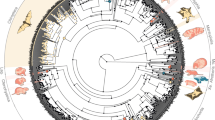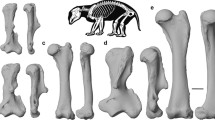Summary
Increasing body density by increasing bone density has been cited as a means by which semiaquatic mammals are able to control their buoyancy in water. In order to investigate the relationship of bone density to buoyancy and the degree of morphological adaptation to a semiaquatic existence, we examined limb-bone densities in a single mammalian family. Among genera within the Mustelidae, i.e., weasels and their relatives, there is an apparent trend toward increasing limb-bone density associated with a gradation from a terrestrial to an aquatic way of life. However, the association of increasing bone density with increasing adaptation to an aquatic environment is tempered by the realization that increasing body size may also influence bone density in larger, terrestrial mammals. These results are in accordance with previous data on bone density in other mammalian orders and suggest that a new hypothesis which encompasses historical, physiological, and behavioral information would be best suited to explaining differences in this morphological relationship.
Similar content being viewed by others
References
Alexander RMcN (1990) Size, speed and buoyancy in aquatic animals. Am Zool 30:189–196
Alexander RMcN, Maloiy GMO, Hunter B, Jayes AS, Nturibi J (1979) Mechanical stresses in fast locomotion of buffalo (Syncerus caffer) and elephant (Loxodonta africana). J Zool, Lond 189:135–144
Aleyev YuG (1977) Nekton. W Junk, The Hague, p 435
Baker RH (1983) Michigan mammals. Mich State Univ Press, Detroit, p 642
Calder WA (1984) Size, function, and life history. Harvard Univ Press, Cambridge, Massachusetts, p 431
Chanin P (1985) The natural history of otters. Facts on File, New York, p 179
Clarke MR (1979) The head of the sperm whale. Sci Am 240:128–141
Currey J (1984) The mechanical adaptations of bones. Princeton Univ Press, Princeton, New Jersey, p 294
Dunstone N, O'Connor RJ (1979) Optimal foraging in an amphibious mammal. I. The aqualung effect. Anim Behav 27:1182–1194
Erlinge S (1969) Food habits of the otterLutra lutra. L. and the minkMustela vison Schreber in a trout water in southern Sweden. Oikos 20:1–7
Estes JA (1989) Adaptations for aquatic living by carnivores. In: Gittleman JL (ed) Carnivore behavior, ecology, and evolution. Cornell Univ Press, Ithaca, pp 242–282
Fish FE (1984) Mechanics, power output and efficiency of the swimming muskrat (Ondatra zibethicus). J Exp Biol 110:183–201
Fish FE, Innes S, Ronald K (1988) Kinematics and estimated thrust production of swimming harp and ringed seals. J Exp Biol 137:157–173
Gray J (1936) Studies in animal locomotion. VI. The propulsive powers of the dolphin. J Exp Biol 13:192–199
Hall KRL, Schaller GB (1964) Tool-using behavior of the California sea otter. J Mammal 45:287–298
Harrison RJ, Kooyman GL (1968) General physiology of pinnipedia. In: Hubbard RC, Peterson RS, Rice CE, Schusterman (eds) The behavior and physiology of pinnipeds. Appleton-Century-Crofts, New York, pp 211–296
Hong SK, Rahn H (1967) The diving women of Korea and Japan. Sci Am 216:34–43
Howell AB (1930) Aquatic mammals. CC Thomas, Springfield, IL, p 338
Johansen K (1962) Buoyancy and insulation in the muskrat. J Mammal 43:64–68
Kenyon KW (1969) The sea otter in the eastern Pacific Ocean. N Am Fauna 68:1–352
Kooyman GL (1973) Respiratory adaptations in marine mammals. Am Zool 13:457–468
Kooyman GL (1988) Pressure and the diver. Can J Zool 66:84–88
Kooyman GL (1989) Diverse divers. Springer, Berlin, p 200
Lenfant C, Johansen K, Torrance JD (1970) Gas transport and oxygen storage capacity in some pinnipeds and the sea otter. Respir Physiol 9:277–286
Ling JK (1970) Pelage and molting in wild mammals with special reference to aquatic forms. Q Rev Biol 45:16–54
Olson SL, Hasegawa Y (1979) Fossil counterparts of giant penguins from the North Pacific. Science 206:688–689
Ridgeway SH, Scronce BL (1969) Respiration and deep diving in the bottlenose porpoise. Science 166:1651–1654
Scheffer VB (1953) Otters diving to a depth of sixty feet. J Mammal 34:255
Schmidt-Nielsen K (1984) Scaling: Why is animal size so important? Cambridge Univ Press, Cambridge, p 241
Seton ET (1909) Life-histories of northern mammals. Scribner, New York, p 1267
Slijper EJ (1976) Whales and dolphins. University of Michigan Press, Ann Arbor, p 170
Stein BR (1989) Bone density and adaptation in semiaquatic mammals. J Mammal 70:467–476
Stephenson R, Lovvorn JR, Heieis MRA, Jones DR, Blake RW (1989) A hydromechanical estimate of the power requirements of diving and surface swimming in lesser scaup (Aythya affinis). J Exp Biol 147:507–519
Tarasoff FJ, Kooyman GL (1973) Observations on the anatomy of the respiratory system of the river otter, sea otter, and harp seal. I. The topography, weight, and measurements of the lungs. Can J Zool 51:163–170
Taylor WP (1914) The problem of aquatic adaptation in the Carnivora, as illustrated in the osteology and evolution of the seaotter. Univ Calif Publ Geol Sci 7:465–495
Walker EP (1975) Mammals of the world. Johns Hopkins Univ Press, Baltimore, p 1500
Wall WP (1983) The correlation between high limb-bone density and aquatic habits in recent mammals. J Paleontol 57:197–207
Williams TM (1983) Locomotion in the North American mink, a semi-aquatic mammal. I. Swimming energetics and body drag. J Exp Biol 103:155–168
Williams TM (1987) Approaches for the study of exercise physiology and hydrodynamics in marine mammals. In: Huntley AC, Costa DP, Worthy GAJ, Castellini MA (eds) Marine mammal energetics. Spec Publ no 1, Soc Mar Mamm, pp 127–145
Williams TM (1989) Swimming by sea otters: adaptations for low energetic cost locomotion. J Comp Physiol A 169:815–824
Wolff JO, Guthrie RD (1985) Why are aquatic small mammals so large? Oikos 45:365–373
Author information
Authors and Affiliations
Rights and permissions
About this article
Cite this article
Fish, F.E., Stein, B.R. Functional correlates of differences in bone density among terrestrial and aquatic genera in the family Mustelidae (Mammalia). Zoomorphology 110, 339–345 (1991). https://doi.org/10.1007/BF01668024
Received:
Issue Date:
DOI: https://doi.org/10.1007/BF01668024




